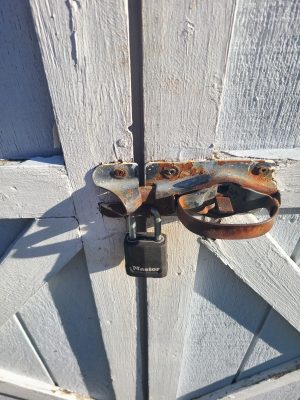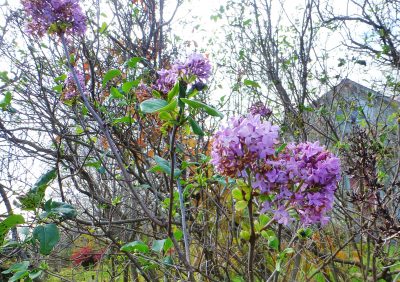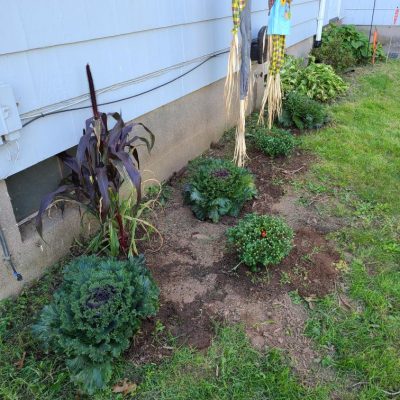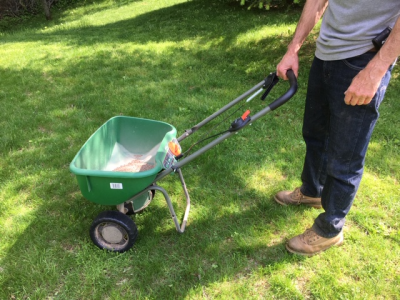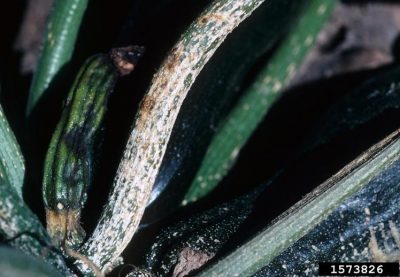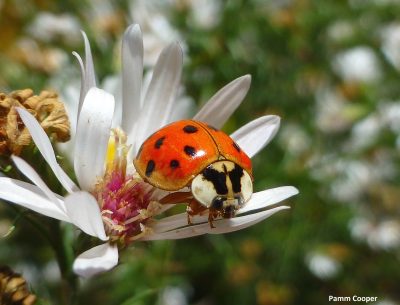00:00:01 Stephen Thal
Hi, welcome to another segment on Focal Point. This is Stephen Thal, your host. And boy, we got another exciting program for our listeners. Today we're going to be talking about plants and gardens and how to take care of them, especially with the challenging weather- humid, hot. Oh, the plants must be having a tough time and garden things. What's happening?
00:00:27 Stephen Thal
Well, here to help us work this all out is Heather Zidack, and she's from the UConn Plant and Garden Education Center. Welcome, Heather.
00:00:40 Heather Zidack
Hi, Stephen. Thanks for having me.
00:00:42 Stephen Thal
Oh, it's always a pleasure. So what did the weather do to the plants this year?
00:00:49 Heather Zidack
So, this year was a wild year for our plants. It was a wild year for us too. Some of the weather that we noticed was quite crazy. But in particular, we had a very hot, very humid summer that led us to see a lot of fungal diseases. We got a lot of phone calls, a lot of emails, a lot of samples into our diagnostic lab that had a lot of diseases in the garden. So that was something that we saw. We actually have also been getting reports right now. People are asking us why are their lilacs blooming? And it's because of the stress that we've had this season.
00:01:28 Heather Zidack
So with that heat, that humidity, we've also had some really dry stretches that have kept us kind of right on the border of a drought. We're not quite there yet, but we are in abnormally dry conditions. So when plants are stressed, sometimes they do some really strange things and so people have been seeing their lilacs blooming in the fall when that's normally a spring blooming plant. It's not something that's normal, but it's definitely it's an environmental thing and it's not going to be like detrimental to the lilacs if you are seeing that. So it's it's worth noting, but it's not necessarily need for alarm.
00:02:06 Heather Zidack
We had earlier in the summer, we had the wildfires and smoke from that may have affected some of your plants. Because believe it or not, the air quality can affect your plants in the garden. And so that could have led to some ozone damage, which we see is like curling in the leaves. It can look like distortion in the leaves. So some weird things with that.
00:02:29 Heather Zidack
And then the other thing is that we saw temperatures whenever we went over 85 degrees, usually our common vegetables like tomatoes, peppers, things like that will actually kind of put a pause on. And so, they will not ripen or they may not fruit as heavily. So, we got some calls in saying, “Hey, why have my tomatoes been green for so long?” And it was probably because of the weather.
00:02:56 Heather Zidack
So a lot of things happening, the swings in moisture, so we'd have some really warm days, some really dry weather, and then we'd get kind of a deluge of rain. That kind of also stressed the plants out as well.
00:03:12 Heather Zidack
So we are advising right now to water your plants, especially your evergreens going into the fall. If we're not seeing an inch of rain forecasted, you want to make sure you're out there watering during any of your new plantings, any of your evergreens, anything like that.
00:03:31 Heather Zidack
The drought that we had last fall, so fall of 2024, actually caused a lot of losses in the garden for evergreens, rhododendrons, things like that in 2025 when we were coming into the spring and plants were starting to wake up. So, watering now is going to save you a headache in the spring for sure and if you've had anything like if you have had experience with like fungal disease in your garden this year we're recommending cut all of that tissue back let those leaves drop rake them up and dispose of them don't come compost it because you don't want to put it back into your garden so a lot of different weather patterns have caused the gardeners to have a little extra work this fall I think.
00:04:14 Stephen Thal
Okay so where do we go from here with the weather are we going to be bringing some plants into the house? And and we'll also be checking on the plants that have been in the house that may need some help for the fall.
00:04:32 Heather Zidack
Yeah, so it's definitely that time of year we recommend bringing in your plants when nighttime temperatures are 50 degrees or lower. And so, we've kind of been doing okay with that weather-wise but we are starting to get into that time where it's consistent and we're seeing that below 50 degrees.
So, a lot of things if you keep, you know, palms outside or if you keep any citrus trees or anything outside, they need to be in if they're not already. So, some species can be a little more sensitive, so they may have needed to come in already, like even before that 50 degree mark, but that's our rule of thumb.
00:05:13 Heather Zidack
When you start to bring them inside, definitely look them over really well, feel them over really well, make sure that the leaves are smooth, everything is healthy, you're not feeling any kind of like insects or any sticky leaves or anything like that. If you are, it is time to kind of have a little bit of a closer look, have checked out for bugs, make sure that you're not bringing anything into your house that you don't want staying there for the winter with your plants. You know, check the undersides of the leaves, check through the soil a little bit, and identify and treat any of those issues before they come into the house.
00:05:51 Heather Zidack
So, we do help homeowners if you have pictures, you can send us pictures and we can take a look to see if any of those plant related insects are anything that you need to do anything about before it comes inside.
00:06:07 Heather Zidack
You want to give your plants a chance to transition from inside to outside. So if 50 degree nights is what they're-the goal is and we've been letting the weather come down to that 50 degrees and then you're bringing it into your 68 degree house, that's an 18 degree temperature difference. So they may show signs of stress.
00:06:29 Heather Zidack
They may kind of not be used to the amount of moisture in the air in your home as compared to what was outside, especially as it starts to get a little colder and we start kicking on the furnace and the air is drier inside the home.
00:06:43 Heather Zidack
So keep an eye on your plants, monitor them. Those stress responses may happen, but don't-go ahead and-don't overreact to it. So if you see them drying out, if you see them wilting a little bit, don't change your practices too much. Continue to water as you've always watered. Continue to take all the care that you always have to make sure that they're not drying out, but you're not over watering either.
00:07:12 Heather Zidack
We see a lot of people that will over love their plants and over water them. So you end up kind of seeing things come inside, the wilt, we’ll panic and then we'll put a ton of water on it, which then sends it to swing the other way into that over watering and root rot and things like that.
00:07:30 Heather Zidack
So just keep doing what you're doing, but keep an eye on what's happening to make sure that you can respond if there is an issue.
00:07:39 Stephen Thal
Okay. And that also goes for the local gardeners too. They probably experience a lot of people requesting help during the summer and now how to make best use of their garden.
00:07:54 Heather Zidack
Yeah, yeah. And we're going to start seeing now with, you know, again, weather related, we're going to start seeing frosts. Some parts of the state may have seen them already.
If you have anything like mums or pumpkins outside, those are things that you may want to protect from those frosts.
What happens is that when the dew falls at night and it crystallizes into frost on your plant material, it can actually damage the tissue and that causes your pumpkins to rot faster. It causes a lot of tender flower petals to not look so good.
00:08:31 Heather Zidack
So, what we recommend is to either bring them inside if you just have one mum on the front step, that's easy to bring in and just leave in the kitchen overnight.
00:08:40 Heather Zidack
But if you have a larger grouping of plants or if you have some, you know, some cole crop vegetables or something like that that you may want to protect, you can use something as simple as a bed sheet or a towel even.
Never use a plastic tarp or anything to cover plants because that will just exacerbate the cold against the plant tissue, but definitely do find a way to cover them if frost is coming or bring them inside.
00:09:12 Stephen Thal
What kind of covers can you use?
00:09:14 Heather Zidack
So, anything that is fabric based is going to work really well. They do sell specific like frost covers, but you don't have to go that far.
If you have an old sheet, if you have towels, a pillowcase even, kind of depends on your plant size, but a lot of those just to keep that frost from falling onto and making contact with the plant tissue.
00:09:37 Stephen Thal
Okay so now we got to get in and roll up our sleeves and begin the work to preparing the plants as Heather has been saying earlier because of the weather and now she's trying to talk a little bit more specifically about plants that come in the house to make sure they don't have some sort of a disease, which will impact the plants that are in the house as well.
Now, is this the time too, because of the changing of the sunsets and amount of light coming in, you have to move your plants inside the house to different positions in the house.
00:10:21 Heather Zidack
So not necessarily different positions. Plants that we have indoors go through yearly cycles just like the ones outdoors. And so some of them may be able to tolerate that change in light as they adjust because it happens slowly. Always check your plant label to make sure if it needs like a full sun or indirect sun.
You know, we've talked about before those differences are kind of like if you think about a cat in the living room, right? So, if it needs bright indirect light, maybe the cat is somewhere that the light is not shining through the window but it's right next door versus if it needs bright direct light, the cat is sitting right in the window and if it needs shade, it's over by the couch and you don't see it necessarily.
So, if you always kind of think about in that way, you can remember where your plants need to be in terms of their labeling, which is important to follow.
00:11:14 Heather Zidack
But they do adapt a little bit over time when they're indoors, which is why we need to help them adapt when they go outside.
So if you keep them in a place that is draft free, bright enough for whatever their requirement is, and away from any of the heat sources, so away from any radiators, vents, anything like that that can dry them out, keep them away from like being too close to wood stoves obviously, and that will help them to not be too dry so they don't lose water as quickly. But the other thing too is that like I said, they go through those yearly cycles, so they will go dormant just like the outdoor plants.
00:11:58 Heather Zidack
Cooler temperatures, changes in light, changes in water can trigger dormancy, but it is species dependent and so with our houseplants because we keep them in a steady environment as possible, some years they'll go into dormancy, some years they won't.
And so it's just kind of knowing what plant you have and whether to expect that or not. That can be really helpful. The other quick tip with houseplants that I like to remind everybody is that we allow the soil to dry in between waterings.
00:12:32 Heather Zidack
So don't keep your soil wet when your plants are indoors. Let it dry out as much as you can in between to help prevent fungus gnats. Those are those little black flies that seem to get everywhere.
Again, follow what your plant needs for watering, but if you can stretch it and let it dry out a little bit, you're going to help reduce that issue.
00:12:54 Stephen Thal
Oh, that's great. Is this also a time to take a look at repotting any of the soils or any of the plants that we're bringing in or the house plants that have already been there.
00:13:07 Heather Zidack
You certainly can.
00:13:09 Heather Zidack
People like to repot either in the fall or in the spring. Usually when you repot in the fall, it can be good if you've had them outside and you're worried about any critters that may come in with them in the soil. It's a good time to do it.
You can do it in the spring if they've put on a lot of growth over the winter while they've been indoors.
So it all matters on checking the plant in the pot to see if there's any presence of any kind of insect or anything.
00:13:40 Heather Zidack
You're definitely going to want to change out your soil. But also if the plant is, those roots are a little too tight in the pot, it starts to get root-bound, that's more your sign of whether to do it or not. It doesn't have to be on a time frame per se.
00:13:56 Stephen Thal
Okay, this is Stephen Thal with another segment on Focal Point, and we're interviewing Heather Zidack from the University of Connecticut Plant and Garden Center up in Storrs, Connecticut.
00:14:08 Stephen Thal
And she'll give us some phone numbers that we can call regarding if you need some help with your plants or the garden that you've been doing.
Heather, you got some phone numbers we can use?
00:14:24 Heather Zidack
Absolutely.
So, if you have questions about anything in the garden, anything plant related, your house plants, anything that you have that you you keep for plant material, we can help at the Home Garden Education Center.
That number is 877-486-6271. Again, that's 877-486-6271 or you can always e-mail us at ladybug@uconn.edu. Again, that's ladybug@uconn.edu.
00:15:03 Heather Zidack
We look at pictures to help with diagnosis, so sometimes a picture says a thousand words. Also, I can give you the phone number too. It's a great time of year to be doing soil testing.
So, the Soil Nutrient Analysis Lab, their number is 860-486-4274. Again, that's 860-486-4274.
00:15:26 Heather Zidack
So, between the services in the Home Garden Education Center, we work with our plant diagnostic lab and then the soil lab. We have pretty much everything that the home gardener or plant enthusiast needs to make sure that they're keeping their plants healthy.
00:15:45 Stephen Thal
That's good.
00:15:45 Stephen Thal
What about fertilizers?
When does that come into play?
00:15:50 Heather Zidack
Yeah, that's a good question. So at this point, we should not be fertilizing anything. There are some exceptions for like lawn care and things like that, but my colleague is much more versed in that.
00:16:05 Heather Zidack
In general, it is too cold to fertilize anything right now because what's going to happen is if you were to put down any plant food,you would be pushing growth and any growth that's new on plants is very tender and very small and very susceptible to damage.
So, it'll push out new growth and then it would freeze and cause damage and not do so well for your plant. So, we don't recommend fertilizing at this point in the year.
The next time that you would be able to or you should would be for the springtime, once the soil temperatures start to climb up again and it starts to warm up.
00:16:46 Heather Zidack
If you have houseplants, you can fertilize.
00:16:50 Heather Zidack
However, some of them only need it once a year. It really depends on the species of houseplant you have.
And so again, like I talked about over loving our plants with watering, sometimes we can over love our plants with fertilizer and, you know, overfeed them. And so sometimes we don't want to do that. So it's something to be aware of.
Usually, as long as the plant is in active growth, you're able to fertilize. And so since we're kind of in that time of year where things are winding down and going to bed for the season, we just don't do it. But it all depends on what you're growing and what you have to keep an eye on.
00:17:30 Stephen Thal
Okay, what are some of the other things that we need to take care of in the fall?
We did mention, we talked a little bit about fertilizer.
We talked about bringing plants into the house. Making sure they're not bringing some critters in.
00:17:43 Stephen Thal
What about the compost pile? Is that something that we do all year round or just certain times of the year?
00:17:50 Heather Zidack
Yeah, composting is year round. So you want to make sure that you're continuously turning your compost pile. There's a couple different kinds.
So there's hot composting where you keep your compost pile at 140 degrees by turning it throughout the year.
There's also cold composting, which is what I'm a little better at, where you kind of throw it together, turn it when you can, but it takes longer and it may not necessarily take out all of the pathogens and weed seeds in the same way that hot composting will. So you have to be really careful with your compost at that point.
00:18:25 Heather Zidack
Which is a good thing to keep in mind because right now, we advise people who are doing their garden cleanup for the season.
There's a lot of controversy between that going for do I clean up in the fall or do I clean up in the spring? And so, what I tell people with that is to maintain what I call goal-oriented gardening. So, if your garden is all about pollinators and wildlife support and native plants and all of that. Definitely clean up in the spring. Don't cut back your perennials right now. You can leave your leaves a little bit. That leaves habitat options like hollow stems, leaf litter, and all of that for overwintering insects. And it leaves seed heads for birds to feed on as well as for winter interest.
00:19:16 Heather Zidack
However, if you have had a lot of disease this year and we talked about like with all the weather conditions, we saw fungal disease, people had, you know, if you had insects in your garden this year or things like that that you needed to manage, then one of the best things that you can do is clean up your garden in the fall.
00:19:37 Heather Zidack
And it goes against that instinct to leave the leaves and leave that pollinator habitat, however, it does help us to reduce our need for chemicals and other products in the spring and the following season because you're taking out anything that's potentially infected and just disposing of it right now instead of letting it overwinter and come back in the next season. So, if you've had disease in the garden and your goal is to have to try to not have that happen again next year.
You want to clean up all your leaf litter, you want to pull up all your sick plants, dispose of everything in the garbage, don't compost it. You know that you are removing some of those habitat opportunities for the pollinators, but you're keeping your plants healthy for them to come back to and find next season. So it's kind of a toss up between the two.
00:20:31 Heather Zidack
And so I always encourage gardeners to really look at their own personal goals in their garden and see what they're willing to work with. If they really want that pollinator habitat to clean up in the spring, go for it. If they want to manage the disease, then fall may be the better time. And the other thing to keep in mind that I encourage people is to think about their own time.
00:20:56 Heather Zidack
So your time is valuable when it comes to garden cleanup. And make sure you're doing what you have time for when you have the time. So I've explained this and I've talked to other gardeners about this and I am a big football fan and so on Sundays, I am watching football instead of being out in my garden, believe it or not.
And so sometimes for me, cleaning in the spring allows me to have that extra hobby and so it's kind of looking at my time and my priorities and really making sure that my garden is fitting that.
00:21:31 Heather Zidack
Because at the end of the day, we all do gardening as something we enjoy, and we want to make sure that we continue to get out there to enjoy it.
00:21:40 Stephen Thal
Okay, are there any other major things that we need to cover at this point, Heather?
00:21:46 Heather Zidack
One of the things that I definitely encourage people, like right now, if you're out in the garden, make sure that you're digging up any of your bulbs. It's the bulb time of year.
So when I say dig up bulbs, I mean all of your elephant ears, your canna lilies, your gladiolus, any of those annual bulbs should be dug up, put into paper bags for storage. If you're growing them in containers, you can just cut them back and put the container in the garage or the basement to make sure that it will stay cool, but it won't freeze.
On the other side of that, you want to start planting your spring blooming bulbs right now, you want to plant your garlic in late October, early November, you want to remove your vegetable plants that have those signs of disease, and don't compost again like I had mentioned.
00:22:39 Heather Zidack
The other thing that you want to do is you want to try to cover your soil in any of your garden beds. So a lot of the perennial garden beds that you have and a lot of your foundation plantings and things like that may already have mulch around them, so it might not be as important.
But for your vegetable gardens and things that you're turning over every year, it's important to make sure that that soil is covered for the winter. Some gardeners were able to put in some cover crops by now and have something to hold the soil, like plant material-wise, that they'll be able to turn in. However, at this point in the season, we recommend just using something like straw, leaf mulch. You can chop up your leaves and put them out onto the garden as long as they were disease free.
00:23:29 Heather Zidack
And what that does is when you break up your leaves and you chop them up first, it allows them to break down faster so that there's less cleanup for you in the spring instead of having like if you've ever seen outside the dense thick leaf patches that we tend to have in the spring where leaves have collected. You want to make sure that they're chopped up, they're fine and that they're able to be turned into the soil at the end of the season.
When you do, if you do have anything that you're turning in, so if you're going to do the leaves this fall and turn things in in the spring, it needs to be about three weeks before you're planting in the springtime. So, keep that in mind.
00:24:11 Heather Zidack
Make sure that you are cutting back any of your perennials, if fall cleanup is your goal, this is the time to do it. You want to cut back and leave one third of the perennials above the ground.
So, say you have a six inch perennial, you want to cut it back to a two inch stub and that's where you'll leave it for the fall if you decide to clean up now.
00:24:35 Heather Zidack
If conditions continue to stay dry like they have been, keep watering all of your trees, your shrubs, your perennials, especially your new plantings until the ground freezes. So we've still got a little bit of time that we should be watering with supplemental water.
We recommend one inch of water a week, which actually ends up being about, I think it's like 0.62 gallons per square foot. So that can help you kind of figure out how much water you need in a week for your plants.
00:25:07 Heather Zidack
And you want to wait till all your shrubs are dormant so their leaves have dropped before pruning in the fall. Do not prune any of your spring blooming shrubs.
So, you don't want to prune your hydrangeas. You don't want to prune your forsythia, your lilacs, anything like that because things likely already set their buds for next year already. So, if you prune them now, you could lose your flowers.
00:25:34 Heather Zidack
The other thing that we recommend is, like I said, you don't want to fertilize anymore at this point. You know, consider getting your soil tested now so that you can have those results in the spring and be able to hit the ground running.
00:25:48 Heather Zidack
And again, like I said, our office is open year-round to help support with any of these home garden houseplant questions that you may have.
00:25:59 Stephen Thal
And also you have a number of local gardeners, don't you, or grangers?
00:26:05 Heather Zidack
We do. We have county offices that will help with garden questions as well through our master gardener colleagues will help with identification and things like that. If it's disease questions, definitely send it to the Home Garden Education Center.
00:26:23 Heather Zidack
But the master gardeners at the county offices are also very well equipped to help with cultural questions, how to take care of plants, how to identify them, and some of these fall and spring cleanup tips as well.
00:26:36 Stephen Thal
Do you have many fruit plants that need to be taken care of, or are they all pretty much gone?
00:26:43 Heather Zidack
They're pretty well done the only one to keep in mind is your fall blooming raspberries or your fall fruiting raspberries those you want to prune after fruiting is complete otherwise you're going to be all set um mostly in the winter when things are totally dormant so we're looking at like March would be the time to start pruning your fruit trees.
00:27:04 Stephen Thal
Oh okay one other thing I forgot to ask you you also have to take clean your tools that you use the garden with.
00:27:12 Heather Zidack
Absolutely. That's a great winter chore. Clean your tools, especially if you're between pruning diseased plants.
The other thing is in the winter, it's great to not only clean your tools, but if you need to sharpen your tools or it's a good time also to make sure that you repaint all the handles so you can find them again when you have them in the garden.
00:27:34 Stephen Thal
Hey, Heather's going to give us the phone number one more time in case you missed it the first time.
00:27:40 Heather Zidack
Yes. So if you have any plant or garden questions, you can always call our office at 877-486-6271. Again, that's 877-486-6271.
00:27:55 Stephen Thal
That'll be great.
Well, thank you again for coming again to help our gardeners or people that have interested in starting gardens or plants or whatever. Great information.
Give my best to your whole team and I know when it comes around Christmas there's a lot of plants there that have to be protected once the season goes by.
00:28:20 Heather Zidack
Yes, yeah there's a lot of holiday plants that we could certainly talk about.
00:28:26 Stephen Thal
Okay well thank you again and wishing you and the whole team at UConn Plant and Garden Center continued success.
00:28:33 Heather Zidack
Thank you so much.
00:28:35 Stephen Thal
Stephen Thal with another segment on Focal Point.
I want to thank all of you for listening.
And a couple of things we want to remind you of is first, make sure that you wear a hat and dark glasses to protect your eyes against the sun all year around, particularly during the winter, particularly if we get snow, be a lot of glare.
00:28:59 Stephen Thal
The other item I wanted to mention is to make sure that you have an emergency plan and practice it. If you need any help with it, call your local fire department or police department and they can direct you to the proper resources to help you build one of these plans because someday that life may be somebody in your family that you save.
00:29:23 Stephen Thal
And also when you travel, make sure you know what the emergency rules are so that should you get into a situation, you know what to do.
00:29:33 Stephen Thal
So once again, thank you all for listening.
Stay safe and stay healthy.

